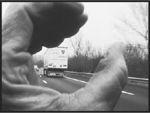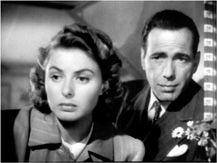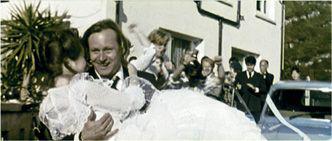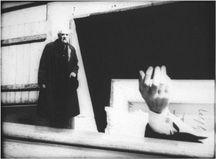B0041VYHGW EBOK (65 page)
Authors: David Bordwell,Kristin Thompson

André Bazin suggested that shots staged in depth and shot in deep focus give the viewer’s eye greater freedom than do flatter, shallower shots: the viewer’s eye can roam across the screen. (See Bazin,
Orson Welles
[New York: Harper & Row, 1978].) Noël Burch takes issue: “All the elements in any given film image are perceived as equal in importance” (Burch,
Theory of Film Practice
[Princeton, NJ: Princeton University Press, 1981],
p. 34
). Psychological research on pictorial perception suggests, however, that viewers do indeed scan images according to specific cues. In cinema, static visual cues for “when to look where” are reinforced or undermined by movement of figures or of camera, by sound track and editing, and by the overall form of the film. The psychological research is outlined in Robert L. Solso,
Cognition and the Visual Arts
(Cambridge, MA: MIT Press, 1994),
pp. 129
–
56
. In
Figures Traced in Light: On Cinematic Staging
(Berkeley: University of California Press, 2005), David Bordwell studies how the filmmaker uses staging and frame composition to guide the viewer’s scanning of the shot.
www.thescenographer.com/
Website for
The Scenographer
magazine, which deals with production design and costume design; has some online articles.
www.makeupmag.com/
Website for
Make-Up Artist Magazine,
professional journal for film and television workers; has some online articles.
www.16-9.dk/2003-06/side11_minnelli.htm/
In a well-illustrated article, “Medium Shot Gestures: Vincente Minnelli and
Some Came Running,
” Joe McElhaney provides a very good example of close analysis of long-take staging. The page is hosted by the Danish online magazine
16:9.
Recommended DVD Supplementscontinuityboy.blogspot.com/2007/03/seeing-spots.html/
Visual researcher Tim Smith measures viewers’ eye movements when they watch films.
DVDs often include galleries of designs for sets, costumes, and occasionally make-up. Documentaries on the subject include
Pulp Fiction
’s “Production Design Featurette.” The unusually large, labyrinthine, enclosed spaceship interior in
Alien,
as well as the film’s other sets, are discussed in the “Fear of the Unknown” and “The Darkest Reaches” segments. (The former also deals with costume design.)
Speed
’s “On Location” supplement deals with the 12 different buses that appeared at various stages of the film’s action, as well as how the freeway locations were used. “Magical Places,” a supplement for
The Da Vinci Code,
is an excellent demonstration of the logistics of going on location: permissions needed, technical challenges (such as lighting real interiors), and the substitution of one real building for another. Three supplements for
The Golden Compass—
“The Alethiometer,” “Production Design,” and “Costumes”—offer particularly detailed examples of prop, set, and costume design.
The DVD for
Hellboy II: The Golden Army
includes a lengthy documentary, “Hellboy: In Service of the Demon.” In one lengthy segment, Doug Jones is made up as the Angel of Death while offering a fascinating discussion of makeup and acting—including how digital controls move the eyes in the wings of his costume!
Lighting is an area of mise-en-scene that receives relatively little coverage. An exception is “Painting with Light,” a documentary on cinematographer Jack Cardiff’s work on the extraordinary color film
Black Narcissus.
A brief but informative look at lighting comes in the “Shooting on Location: Annie’s Office” supplement for
Collateral.
In the “Here to Show Everybody the Light” section of the “Working like a Dog” supplement for
A Hard Day’s Night,
director of photography Gilbert Taylor talks about how high-key lighting on the Beatles achieved the characteristic look of the images and about such challenges as rigging lighting equipment in a real train.
Toy Story
’s “Shaders and Lighting” section reveals how computer animation can simulate rim and key lighting.
Hellboy
cinematographer Guillermo Navarro presents and discusses some lighting tests in “
Hellboy:
The Seeds of Creation.”
Auditions are commonly included in DVD supplements, such as those for “The Making of
American Graffiti
” and especially
The Godfather
—where 72 minutes cover the casting, including many screen tests! Some discs go more deeply into aspects of acting.
Collateral
’s extras include a short segment, “Tom Cruise & Jamie Fox Rehearse.” “The Stunts,” included with
Speed,
shows how the drivers’ maneuvers with the vehicles involved in the accidents and near-misses were choreographed using models, as well as covering how decisions are made about whether to let stars do their own stunts. “Becoming an Oompa-Loompa” details the training Deep Roy underwent to play all the Oompa-Loompas in
Charlie and the Chocolate Factory.
A detailed exploration of the distinctive acting in the films of Robert Bresson is offered by Babette Mangolte’s “The Models of
Pickpocket,
” including lengthy interviews with the three main performers recalling the director’s methods.
The
Dancer in the Dark
supplement “Choreography: Creating Vincent Paterson’s Dance Sequences” takes an unusually close look at this particular type of staging. (This section can be best appreciated if you have watched the whole film or at least the musical numbers “Cvalda” [Track 9] and “I Have Seen It All” [Track 13].)
Detailed discussion of staging strategies can be found on a six-DVD set,
Hollywood Camera Work: The Master Course in High-End Blocking and Staging.
The exercises cover stationary scenes, actor movement, and camera movement. See
http://www.hollywoodcamerawork.us/
.

In controlling mise-en-scene, the filmmaker stages an event to be filmed. But a comprehensive account of cinema as a medium cannot stop with simply what is put in front of the camera. The
shot
does not exist until patterns are inscribed on a strip of film. The filmmaker also controls the
cinematographic qualities
of the shot—not only
what
is filmed but also
how
it is filmed. This “how” factor involves three areas of choice: (1) the photographic aspects of the shot, (2) the framing of the shot, and (3) the duration of the shot. This chapter surveys these three areas.
Cinematography
(literally, writing in movement) depends to a large extent on
photography
(writing in light). Sometimes the filmmaker eliminates the camera and simply works on the film itself; but even when drawing, painting, or scratching directly on film, punching holes in it, or growing mold on it, the filmmaker is creating patterns of light on celluloid. Most often, the filmmaker uses a camera to regulate how light from some object will be photochemically registered on the sensitized film. In digital video, the light activates a computer chip, which translates the pattern into ones and zeroes. In either case, the filmmaker can select the range of tonalities, manipulate the speed of motion, and transform perspective.
An image may seem all grays or stark black and white. It may display a range of colors. Textures may stand out clearly or recede into a haze. The filmmaker may control all these visual qualities by manipulating the film stock, exposure, and developing procedures.
Types of
film stocks
are differentiated by the chemical qualities of the emulsion. The choice of film stock has many artistic implications. For one thing, the image will have more or less
contrast
depending partly on the stock used. Contrast refers to the degree of difference between the darkest and lightest areas of the frame. A high-contrast image displays bright white highlights, stark black areas, and a narrow range of grays in between. A low-contrast image possesses a wide range of grays with no true white or black areas.
As we have already seen in
Chapter 4
, human vision is highly sensitive to differences in color, texture, shape, and other pictorial properties. Contrasts within the image enable filmmakers to guide the viewer’s eye to important parts of the frame. Filmmakers control the degree of contrast in the image in various ways.
“Both [cinematographer] Floyd [Crosby] and I wanted
[High Noon]
to look like a documentary, or a newsreel from the period of the 1880s, if film had existed at that time—which, of course, it did not. I believe that we came close to our goal by using flat lighting, a grainy texture in the printing and an unfiltered white sky.”— Fred Zinnemann, director
In general, a very fast film stock, one that is very sensitive to reflected light, will produce a “low-contrast” look, while a slower, less light-sensitive one will be high in contrast. The amount of light used on the set during shooting will also affect the image’s degree of contrast. Moreover, the cinematographer may use particular developing procedures that increase or decrease contrast. For example, the strength and temperature of the chemicals and the length of time the film is left in the developing bath affect contrast. By manipulating the film stock, lighting factors, and developing procedures, filmmakers can achieve enormous variety in the look of the film image
(
5.1
–
5.3
).
Most black-and-white films employ a balance of grays, blacks, and whites.

5.1 Most black-and-white films employ a balance of grays, blacks, and whites, as in this shot from
Casablanca.

5.2 In
Breaking the Waves,
color manipulation creates bleached-out images.

5.3 The dream sequence early in Ingmar Bergman’s
Wild Strawberries
uses a combination of film stock, overexposure, and laboratory processing to create a bleached-out look.